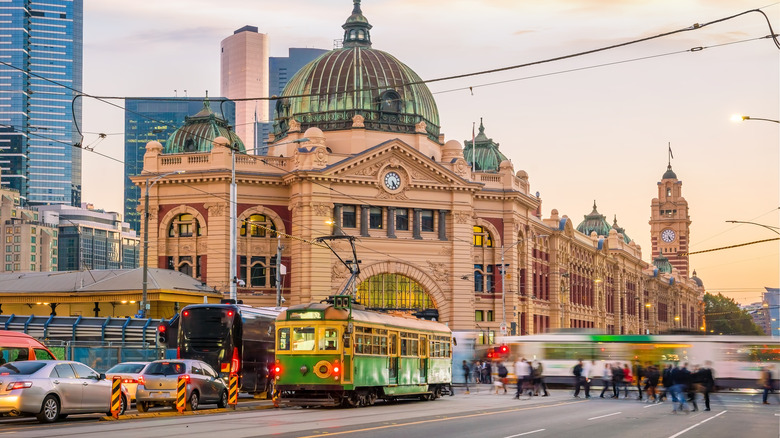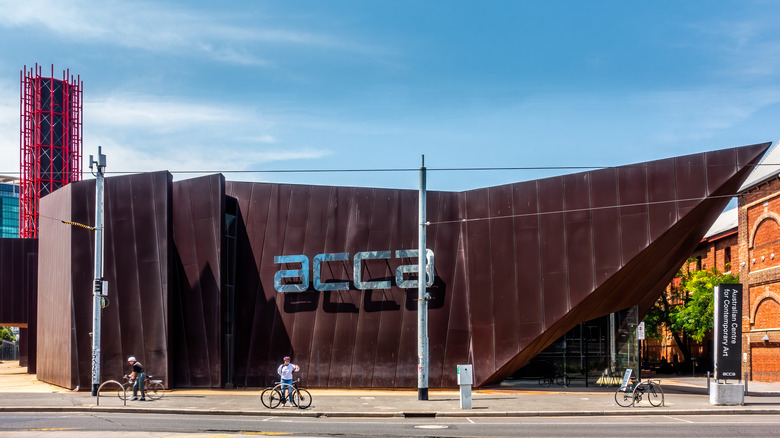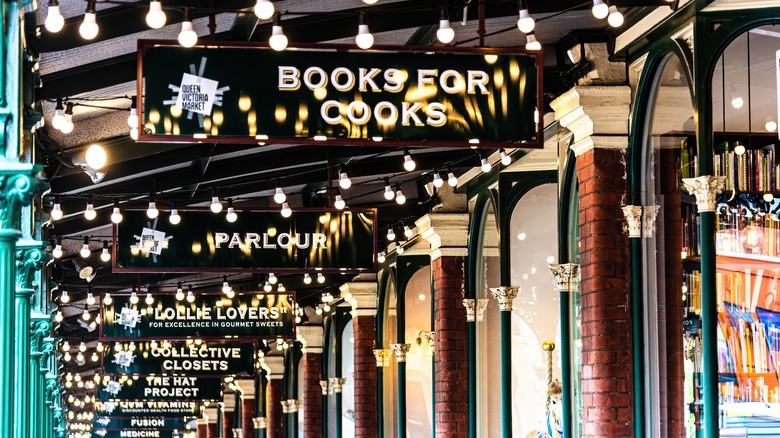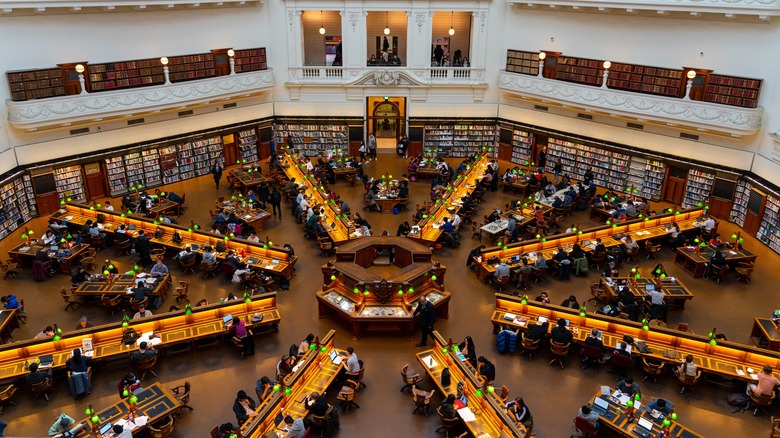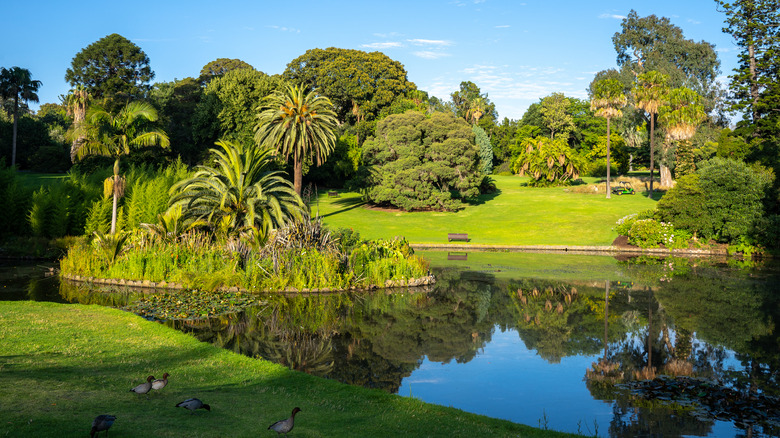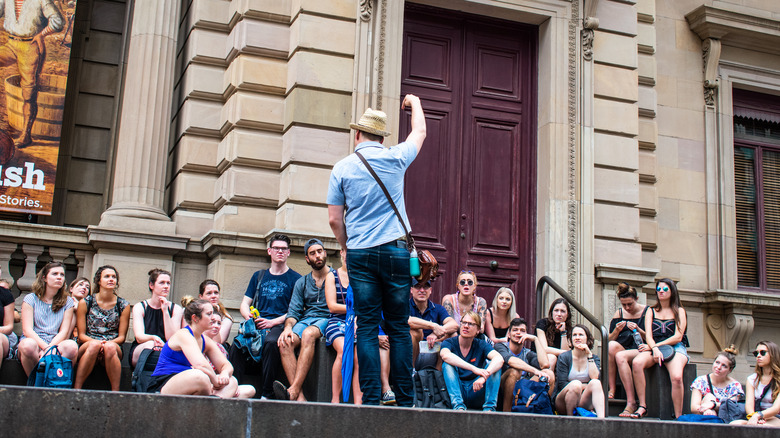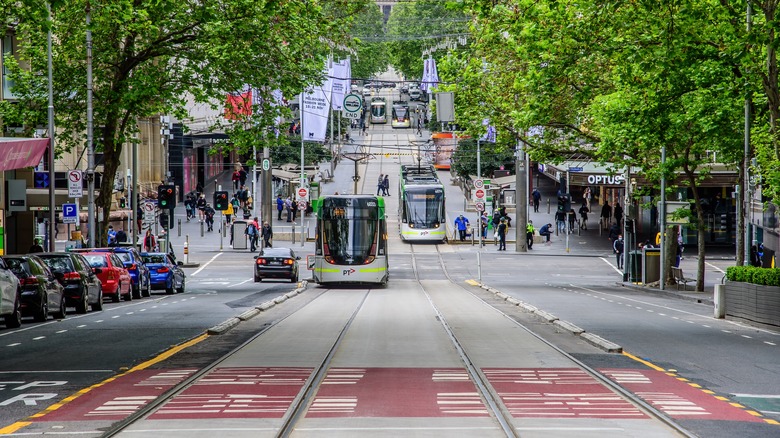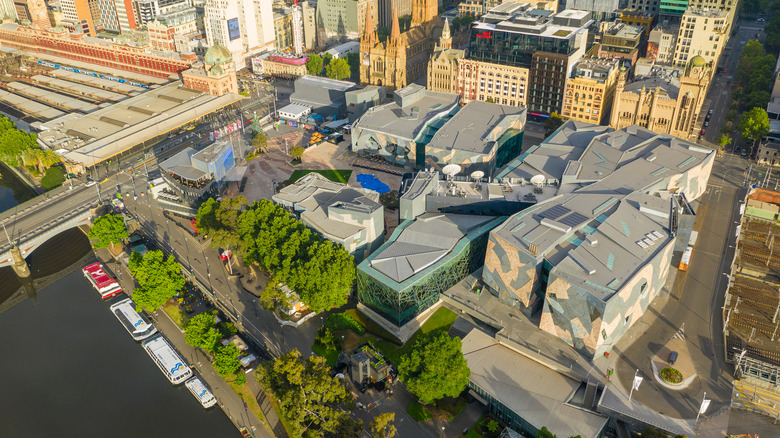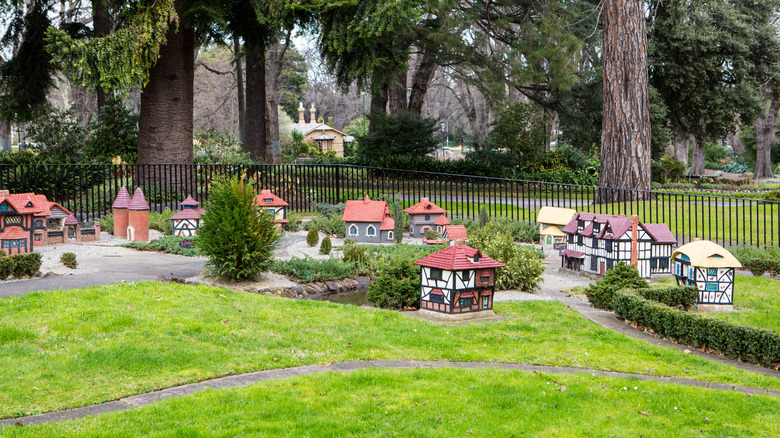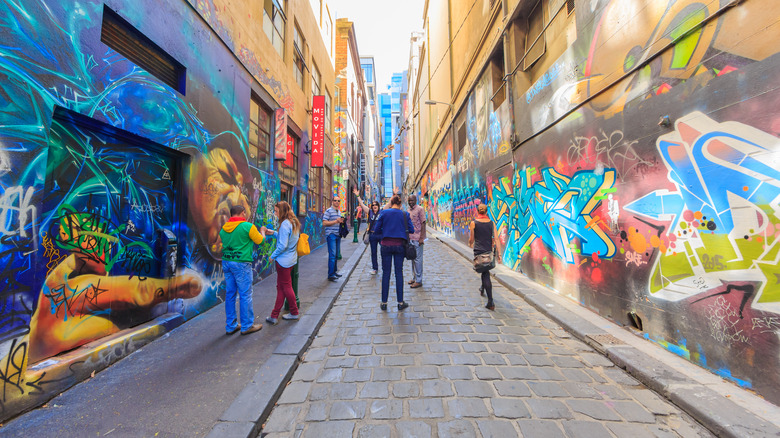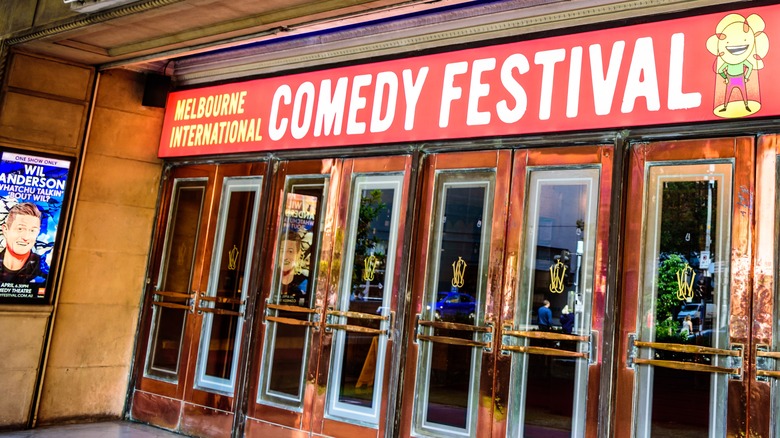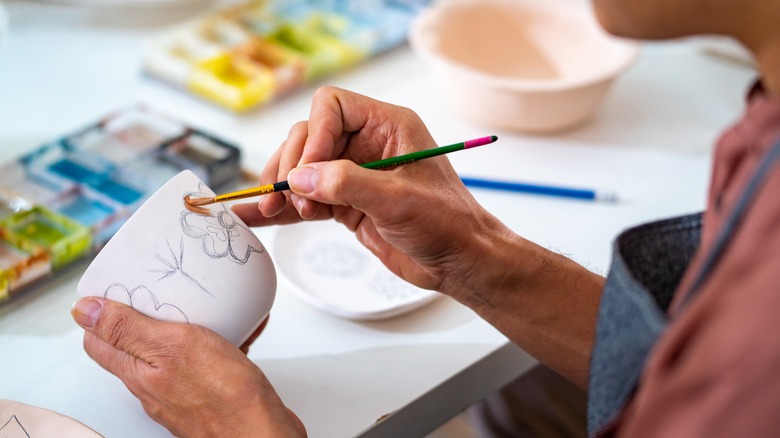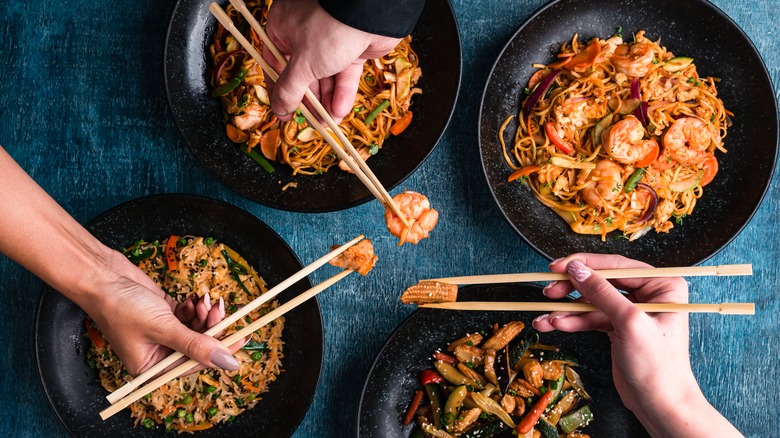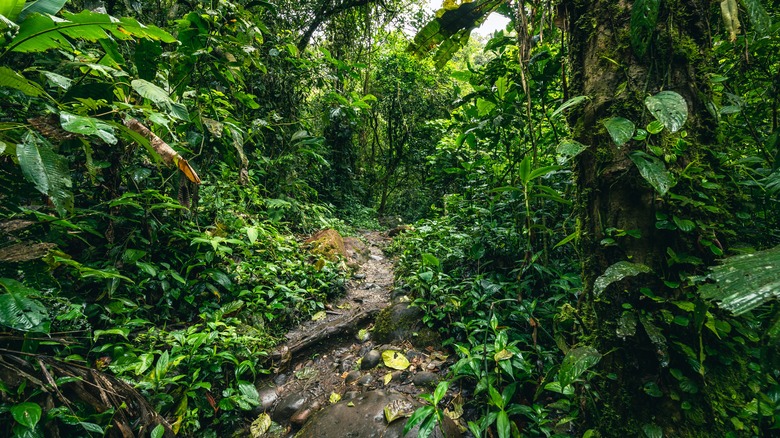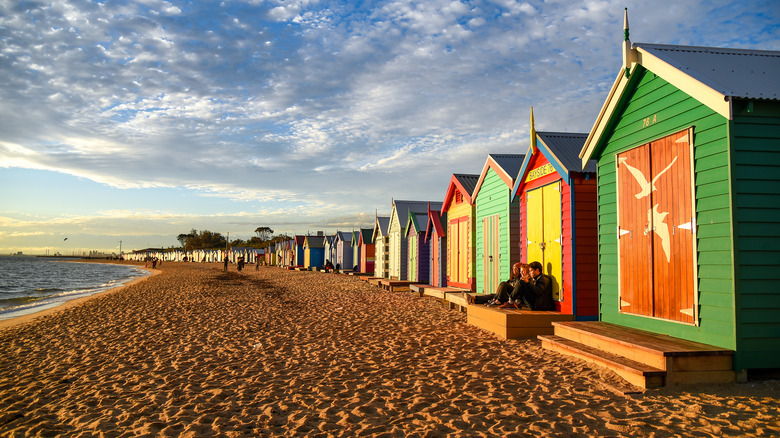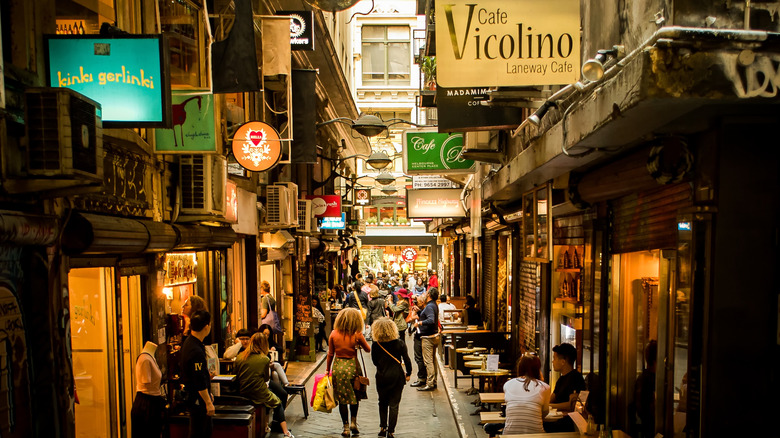The Best Budget-Friendly Things To Do On Your Next Trip To Melbourne
In Australia's southeast and straddling the Yarra River, Melbourne is a cosmopolitan, bayfront city with four seasons — sometimes all appearing on one day— and plenty of attractions. The capital of Victoria state, it's a fantastic place to live, the top Australian city on the Economist Intelligence Unit (EIU) Global Liveability Index 2022 (via Live In Melbourne), and the only place down under to make it on that report's global Top 10.
But such urban bonhomie comes at a price, and the EIU also ranks Melbourne as the 15th most expensive city in the world (via Broadsheet). Nevertheless, there are many ways to make a visit here less painful on the pocketbook. With Australia now fully open to travelers, without the need to take a COVID test or show vaccination status, according to the Australian government, consider this a great time to take in the beautiful sights of this Antipodean gem.
Brush up on some culture
With the population of Greater Melbourne almost reaching 5 million, according to the 2021 Census published by the Australian Bureau of Statistics, the city has a sizeable audience for any cultural attractions. It also understands the importance of making art available to all, so a number of museums in the city are free. With a history that dates to 1861, the National Gallery of Victoria (NGV) is the country's oldest gallery. Today, its two campuses — NGV International and The Ian Potter Centre: NGV Australia — sit a short distance from one another, and together house more than 70,000 pieces of European, Asian, and Aboriginal art. Entry to both is always free.
As the name of the Australian Centre for the Moving Image suggests, anything that involves movement on a screen, from film to art to video games, comes under the microscope at this contemporary building recently overhauled by BKK Architects. In South Melbourne, in the city's Arts Precinct, and with a distinctive, angular, rust-worn steel exterior, the Australian Centre for Contemporary Art has four large galleries where it exhibits works by local and international artists.
Look for bargains
An iconic destination in the city, and operating for more than 140 years, Queen Victoria Market is free to enter and is packed with 600 vendors selling fresh fruits and vegetables, specialty food stalls, bakeries, clothing outlets, toys, and much more. The building that houses the market stretches over two full city blocks, and the market is revered with such high cultural regard that it was added to the country's National Heritage List in July 2018 for playing a key role in helping the country with its drive to urbanization. It offers special deals on select days — known as Dizzy Deals — that will return in 2023 after a hiatus for the 2022 end-of-year holidays.
Elsewhere, in a lively waterfront section of the city, a part of Melbourne that a colony of Little Penguins calls home, the St. Kilda Esplanade Market is a beloved Sunday distraction for Melburnians. Reachable by tram from the city center, the market is known for its artisanal, handmade offerings — jewelry, crafts, and items for self-pampering.
Become a bookworm
A Victorian landmark in the heart of the city, and the oldest library in the country, State Library Victoria is a reader's nirvana, with millions of book, journals, and magazines, and more than 70,000 items of historical importance. What's more, it's a gorgeous destination in itself, first opened in 1854 and now comprises more than 20 buildings, though the most famous is the serene Neoclassical edifice facing Swanston Street.
The interiors are no less grand, with plenty of natural light, wooden floors, and columns throughout. Among the highlights are the octagonal La Trobe Reading Room, topped by a dome, and the Ian Potter Queen's Hall, which feels like a time capsule from the country's past, and where some tables and chairs date to the 1850s. The independent bookstore Readings has eight stores in Melbourne, including a small outlet in the library, offering visitors of this beautiful cultural hub an opportunity to browse and buy.
Go green
With almost two centuries of history, the Royal Botanic Gardens Victoria (RBGV) spreads over 94 acres, not far from the port, and is home to an impressive selection of plants from around the planet, with more than 8,500 species on display. As a further sweetener, entry is free. In addition to plants, herbs, cacti, and flora from diverse locations, the garden also has a section devoted to threatened species from the surrounding region. Other attractions include a sensory journey called Sonica Botanica, an art project that broadcasts sounds and music inspired by the natural environment. RBGV also has separate gardens in Cranbourne, a southeastern suburb of the city, with much more of a bushland feel and a focus on native Australian plants.
Back in the city center, and set by the stately Royal Exhibition Building, an events arena in the heart of the city, Carlton Gardens is an open green space with wide walking paths and the feeling of a grand European park. The gardens and the events center, together, are part of the UNESCO World Heritage Convention.
Explore the sights with a guide
Melbourne is not a difficult city to navigate by foot — it's mostly flat, has a city center that follows a grid system, and the streets are well signposted. But for a more in-depth, cost-effective take on the city by foot, and replicating a similar model seen in other cities around the world, the guided rambles run by I'm Free Walking Tours cost nothing, though participants are encouraged to show their appreciation with whatever they see fit at the end of each tour. Guides are Melbourne residents, so beyond the usual show-and-tell imparted during each outing, they can answer all and any questions visitors might have about the city.
Walks can last up to three hours, though are at a leisurely pace, and a percentage of any takings from guests goes to charity. During a typical tour, visitors might learn about the area's Aboriginal past, the Australian outlaw Ned Kelly, and the city's old jail.
Travel for free
As we've just mentioned in the previous entry, walking around Melbourne isn't particularly taxing, but it's always nice to give the calf muscles a break. The city's free tram zone lets travelers do that without the need to part with a cent. The area within that zone is a tourist's nirvana, taking in many of the city's prime sights in and around the Central Business District, and extending to popular haunts like Queen Victoria Market, Parliament House, St. Paul's Cathedral, Docklands, and Federation Square.
Beyond this, the tram system ventures far past this zone, serving the city far and wide, and remarkably it is the largest tram network in the world, run by Yarra Trams. Among the eye-opening statistics, the network has about 250 kilometers (or 155 miles) of double track, 25 separate tram routes, has operated for more than a century, uses power derived from solar panels, and handles more than 200 million rides per year.
Take the pulse of the city
The beating heart of Melbourne, Federation Square — known locally as Fed Square — is where locals and tourists like to hang out, swap stories, chat, take tai chi classes, grab something to eat, visit a museum or gallery, or just simply take a break. First opened in 2002, and surrounded by modernist architecture that might grate some onlookers, it was voted the sixth-best public square in 2014 by the Landscape Architects Network, a social media platform for that genre of architects. More than just a civic space near the Yarra River that has great public transport connections, Fed Square is where to find the Australian Centre for the Moving Image, the Koorie Heritage Trust, which showcases Aboriginal art, and Ian Potter Centre: NGV Australia.
It's also home to plenty of free events on its spaces, from musical performances to movie screenings, as well as fun diversions like Gentle Chinese Dancing, pop-up libraries for kids, Santa's workshop, and a brightly lit, 50-feet tall Christmas tree. This is also the place where throngs gather for a raucous New Year's Eve celebration filled with dance, music, and contemporary dance, courtesy of the city's art colleges. Armchair travelers can even watch what's going on from afar by tapping into the square's live webcam.
Peek into a miniature village
A verdant oasis near the Melbourne Cricket Ground and John F. Kennedy Memorial (yes, there is one here, a tasteful granite boulder with a bronze sculpture of the 35th U.S. President mounted on it), the free Fitzroy Gardens is a handsome urban patch of green. Here, visitors can happily while away an hour or two wandering up and down wide walking paths, visiting a conservatory drafted in Spanish Mission style and home to vibrant floral displays, admiring the numerous bronze and stone statues, or munching on a snack while seated on one of the many shaded park benches.
The gardens are also, somewhat bizarrely, home to a model Tudor village, built by an English pensioner and unveiled in 1948, with meticulously crafted thatch cottages, a school, a church, and even a simulacrum of William Shakespeare's home. Combined with the small, carefully tended shrubs and plantings near the painted cement structures, the overall effect is breathtakingly life-like.
Take in some street art
Instagram is the home of scores of pages showcasing the colorful lines, shapes, and forms of Melbourne's street art, and there's good reason for that — the art is really good, and much of it is located close together. Alleys like Hosier Lane, just across from Fed Square, are well known, but other not-so-famous, but equally impressive, spots are tucked away in various corners of the city. This walking map is a few years old, but it has a good handle on some of the places worth seeking out, with a detailed route and pictures of what you'll see at each stop. It's not a long walk, set within the city's core, taking less than one hour to complete.
For what's currently going on in the scene, check out the Melbourne creative initiative Flash Forward — it pairs music with murals in small lanes throughout the city, with constant additions to its roster of tones and tunes. What's more, by exploring on foot, you'll burn off some calories in addition to snapping a raft of photos guaranteed to make your friends and family jealous.
Have a laugh
Australians have a strongly developed sense of humor, and it's much more wide-ranging than simply the material of Rebel Wilson, Crocodile Dundee or Dame Edna Everage, a fictitious character who hails from Melbourne. Australian humor, perhaps not surprisingly, shares many traits with British humor — think sarcasm, self-deprecation, and punchlines that can be drier than the Australian Outback in high summer. Plenty of the manifold delights of Australian humor are on display at the Monday night comedy shows hosted by Spleen Bar, a weekly event that started in the former art gallery in 2008 and is now a city fixture. The shows are an unbelievable bargain, costing only 10 Australians Dollars (about U.S. $7) for two hours of ribald rib-tickling, and feature some of the best local talent as well as surprise guests.
For a real gaggle of giggles, the Melbourne Comedy Festival runs for four weeks, the 2023 edition starting in late March. Shows take place at venues all over the city, with ticket prices from $20 Australian Dollars (about U.S. $14).
Learn a new skill
With status as a non-profit, Laneway Learning was set up in 2012 with the goal of building community, not for the express cause of making money, great news if you're on a budget! It's an extremely relaxed organization, with classes held throughout the city and a main location that couldn't be more convenient — a stone's throw from Federation Square. The emphasis here is not to perfect a skill or receive deep, intense training in a particular discipline, but to get a better understanding of specific fields, to be able to work on them with a little more competence and finesse.
Classes are taught by locals in the community — flower arranging by a florist, for example — not academics or those with doctorates in a subject, so the experiences are informal, nurturing, and non-competitive. Starting at $9 (about $6 USD), the classes are eclectically varied, from painting for newbies to how to sew a hat, from creating dioramas to casting a silver ring, and are a novel, rewarding, and unexpected way to meet and interact with Melburnians.
Enjoy some global eats
Melbourne is incredibly multicultural — evident from the 2021 census figures that showed more than 40% of its population was born outside Australia. Thanks to that, the city has a huge variety of foods that cater to these immigrant communities, and of course devotees of their cuisine, often offering delectable dishes at affordable prices. Along Sydney Road, in Brunswick (a suburb north of Melbourne, easily reached by bus, train, or tram), diners will find a worldly delight of gustatory goodies. This is where to encounter Thai, Ethiopian, Turkish, Indian, and Mexican dishes, along with many others.
The city is also home to a large Vietnamese community, with more than a third of Vietnamese migrants to Australia opting to live in the city. Visitors to Richmond, east of Melbourne, will find a host of Vietnamese restaurants there, with the Australian Good Food & Travel Guide listing more than 20 such eateries in the area.
Take a walk in the rainforest
East of the city, and situated near the Upper Ferntree Gully train station (a stop on the Belgrave Live from Melbourne Central), the 1,000 Steps Trail is part of a larger route that commemorates fallen Australian soldiers. Closed in 2021 after storm damage that knocked out more than 150 trees on and around the walkway, it reopened in October 2022 following extensive work by park employees and volunteers to get it back in shape (via Parks Victoria). The walk is popular with Melburnians, climbing from the Ferntree Gully Picnic Ground up through the dense rainforest of the Dandenong Ranges, populated by gumtrees and fern gardens.
The trail is part of the Kokoda Track Memorial Walk, named for its similarity to parts of the Kokoda Track in southeastern Papua New Guinea, the location of a battle in World War II that involved Australian troops. Along the walk here, 14 plaques serve as a sobering reminder of the sacrifices made during the brutal war.
Hit the beach
Sitting on Port Philip Bay, and bisected by the Yarra River, Melbourne is unquestionably linked to the water. Visitors can enjoy the liquid link with a river cruise or, for those on a tighter budget, a visit to the beach is completely free. Brighton is an upscale neighborhood in the city's southeast and features a beach that is a gentle sweep of sand with views of the city skyline to the north. But what makes it extra attractive for locals and tourists alike are the bright bathing boxes that line Dendy Street beach.
The 82 vibrantly painted changing rooms that date to the Victorian era have archetypal features from that time, hence timber frames and corrugated iron roofs. Strung along the edge of the sand, they appear like a necklace of bright jewels, perfectly positioned for an Instagram shoot. The city is also blessed with many other fine beaches, such as St. Kilda, Middle Park, and Elwood (via Visit Melbourne).
Discover a unique part of the city
Small alleys that connect the city's larger roads, Melbourne's laneways are known as lively, creative micro-environments, populated with small, independent stores, cool restaurants and bars, and tons of interesting artwork. Eco-systems unto themselves, laneways are constantly changing and evolving, welcoming new ideas and businesses, and are a stark counterpoint to the mass market commercialism of the High Street (the Australian equivalent of America's Main Street). Visitors need not be in the mood to buy anything to explore the laneways, they are fascinating places to window-shop, a conduit to the city's creative pulse.
Among a couple of better-known laneways are AC/DC Lane, inspired by the Australian heavy metal band AC/DC (it even has a cool mural of the band's guitarist Angus Young in full guitar-solo charge), and the iconic Flinders Lane, that draws crowds for its food, drink, boutiques, and chance to hop from one gallery to the next. We'll raise a glass to that.
